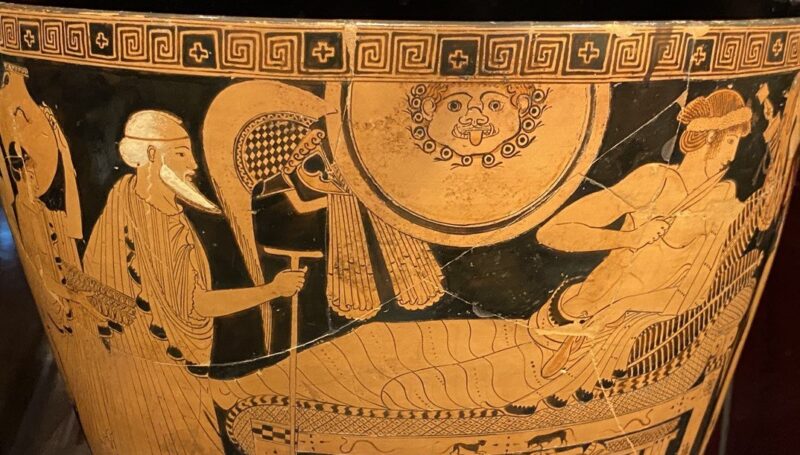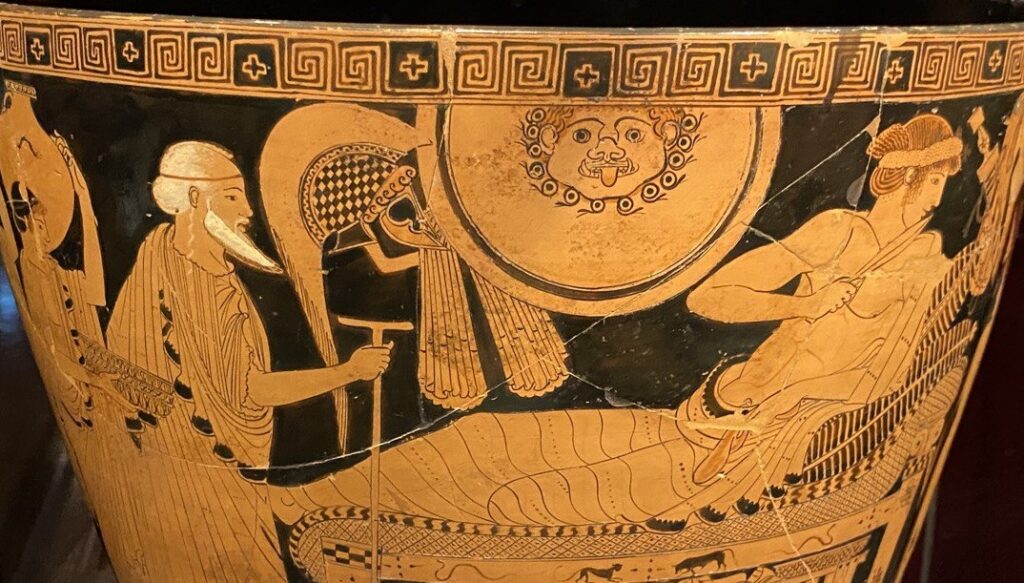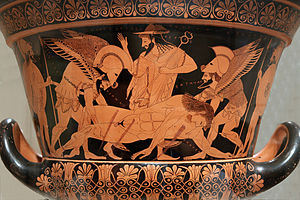The Brygos painter is a celebrated name attached to a number of Athenian pieces dating to the early 5th century BC. On occasion artists might sign their pieces, but this was something potters might do as well. As such Brygos could be the name of the potter, and to complicate things further it could even be that Brygos was both potter and artist. In any case their work was of high quality as you can see from the images. One piece, named the Brygos skyphos, carries a scene from the Iliad, but also much more.
Brygos and the Iliad.
The scene can be seen below and it depicts Priam approaching Achilles to ransom his son Hector. You may recollect that after Achilles killed Hector in battle he dragged the corpse behind him on his chariot before taking it back to camp and keeping it there. A cornerstone of Greek culture was affording the corpse respect and the proper funerary rites. In his actions Achilles had rejected this fundemental and it was further evidence of Achilles as a boundary pusher and breaker of codes (you might remember how he continually challenges convention in the poem).
Achilles was as much a danger to the Homeric code as he was to any Trojan on the plains of Troy.

The composition of the scene is wonderful, as is the skill set. Priam, an old man with a walking stick is at one end of the couch. At the other a youthful Achilles, who be have been stolen from many a scene of a symposium, feasts in luxury. Here we meet a slew of binary oppositions. The old man and the younger one, the reclined versus the standing and also the power dynamic. Priam, a great King, is now in the lowly role of petitioner and Achilles reclines. Often the power on vase painting is indicated by the seated or reclined individual and this is certainly the case here.
But there is something almost hidden within the scene which hints at something much darker.
Hector and barbarity.
In the upper half of the scene Brygos has supplied a scene very much within the experience of a viewer of the time. Men at symposia, men at luxury. This was the tent of Achilles so what else might you expect? The only real indication that we are in a military setting are the wonderfully detailed shield and helmet which is testament to the skill of Brygos. This was Athenian culture at its zenith showcased with no small element of skill.

But when we look under the couch Achilles reclines on it all changes.

The body, with wounds and hands tied belongs to Hector. His eyes shut and wounds still fresh. One reading might be that Brygos is implying that Achilles kept Hector’s corpse in his tent as some macabre trophy. Worst still his father stands close not aware of the horror. However, I don’t read it in this content. For a start having a corpse inside whilst you ate would violate many codes and Homer places it outside of the tent. The inclusion of it by the artists therefore has other functions.
Brygos, composition and comment.
To start with consider the composition. Purely on an aesthetic level the body of Hector mirrors that of Achilles, where you have a vibrant and still alive Achilles feasting you have a dead noble below him. It’s a striking contrast. One is bound and wounded whilst the other reclines in luxury. Brygos is also able to showcase their talent, the corpse isn’t flat, its twisted and though almost seems sleeping the wounds and the context remind us that this is not the case.
What elevates this further is the commentary Brygos may be providing. As mentioned treatment of Hector by Achilles broke convention in regards to how you treated bodies of the deceased. The treatment of Hector’s corpse would be seen as barbaric were Achilles a non-Greek. I see it as representing non-Greekness, of barbarism. The actions of Achilles are therefore contrasted with how we find him now, Achilles the paragon of Greek culture and civility.
We must also consider on what the image was made, a skyphos. This was a drinking vessel and one which would have held wine. The god of wine, Dionysus, was also about duality. Though drinking to celebrate him was enjoyable there was also the darker aspect of him. Drink too much or wander into excess and things can get dangerous. This could all tie in, the barbarism of a Greek hero and a reminder that any civilised Greek could easily fall foul of barbarity. Art can often stimulate discussion and you might consider how this image may have set a conversation in motion about how Achilles acted, what civility and culture meant and perhaps how easily it might dissolve.
If you want to read about more content from the Iliad you can find out about a sporting controversy and something on Sarpedon



